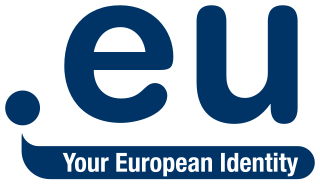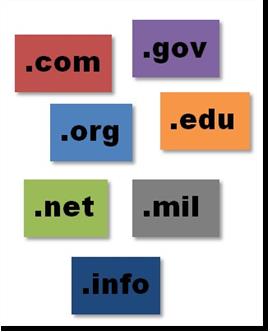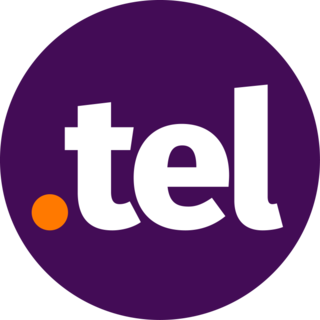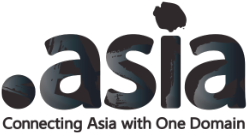Related Research Articles
A domain name is a string that identifies a realm of administrative autonomy, authority or control within the Internet. Domain names are often used to identify services provided through the Internet, such as websites, email services and more. As of 2017, 330.6 million domain names had been registered. Domain names are used in various networking contexts and for application-specific naming and addressing purposes. In general, a domain name identifies a network domain or an Internet Protocol (IP) resource, such as a personal computer used to access the Internet, or a server computer.
The domain name .com is a top-level domain (TLD) in the Domain Name System (DNS) of the Internet. Added at the beginning of 1985, its name is derived from the word commercial, indicating its original intended purpose for domains registered by commercial organizations. Later, the domain opened for general purposes.

.eu is the country code top-level domain (ccTLD) for the European Union (EU). Launched on 7 December 2005, the domain is available for any person, company or organization based in the European Union. This was extended to the European Economic Area in 2014, after the regulation was incorporated into the EEA Agreement, and hence is also available for any person, company or organization based in Iceland, Liechtenstein and Norway. The TLD is administered by EURid, a consortium originally consisting of the national ccTLD registry operators of Belgium, Sweden, and Italy, joined later by the national registry operator of the Czech Republic. Trademark owners were able to submit registrations through a sunrise period, in an effort to prevent cybersquatting. Full registration started on 7 April 2006.

The domain name info is a generic top-level domain (gTLD) in the Domain Name System (DNS) of the Internet. The name is derived from information, although registration requirements do not prescribe any particular purpose.

.xxx is a sponsored top-level domain (sTLD) intended as a voluntary option for pornographic sites on the Internet. The sponsoring organization is the International Foundation for Online Responsibility (IFFOR). The registry is operated by ICM Registry LLC. The ICANN Board voted to approve the sTLD on 18 March 2011. It went into operation on 15 April 2011.
Domain name speculation, popular as domaining in professional jargon, is the practice of identifying and registering or acquiring generic Internet domain names as an investment with the intent of selling them later for a profit.

Generic top-level domains (gTLDs) are one of the categories of top-level domains (TLDs) maintained by the Internet Assigned Numbers Authority (IANA) for use in the Domain Name System of the Internet. A top-level domain is the last level of every fully qualified domain name. They are called generic for historical reasons; initially, they were contrasted with country-specific TLDs in RFC 920.

.co is the Internet country code top-level domain (ccTLD) assigned to Colombia.

The domain name .tel is a top-level domain (TLD) in the Domain Name System (DNS) of the Internet. It was approved by ICANN as a sponsored top-level domain, and is operated by Telnic. Telnic announced in January 2011 that over 300,000 domains had been registered since the start of general availability on 24 March 2009. A substantial drop of mostly IDN .tels occurred at the beginning of 2014 - the current total registered .tels as of 21 July 2016 is 98,516.

The top-level domain .asia is the officially designated regional domain in the Internet for Asia and the Pacific. It is a sponsored generic top-level-domain (gTLD) operated by the DotAsia Organisation Ltd. The domain is open to companies, individuals and organisations that have a connection to the region. Asia domains can be seen and used by international and Asian businesses; regional conferences and symposiums; as well as Asian artists and celebrities.
The sunrise period of domain name registration is a special period during which trademark holders may preregister names that are the same or similar to their trademarks in order to avoid cybersquatting. This occurs prior to the general launch of the top-level domain (TLD). To register, the group or individual must be able to prove their prior right to the name. The sunrise period serves as a test period, and is followed by the landrush period and/or General Availability.

.me is the Internet country code top-level domain (ccTLD) for Montenegro.

.sx is the country code top-level domain (ccTLD) in the Domain Name System of the Internet for Sint Maarten.

.biz is a generic top-level domain (gTLD) in the Domain Name System of the Internet. It is intended for registration of domains to be used by businesses. The name is a phonetic spelling of the first syllable of business.

The ZA Central Registry (ZACR), formerly known as UniForum SA, is a non-profit organisation established in 1988 and operates various second-level domains (SLD's) in South Africa. The ZA Central Registry is the administrator of the South African zones such as "co.za" and "web.za". Their offices are based in Midrand, South Africa.
.saarland (dotSAARLAND) is an ICANN-approved generic top level domain (TLD). It falls into the category of Geographic TLDs (“GeoTLDs”). The new top level domain is meant for all people and businesses in the German Federal State of Saarland and those otherwise associated with Saarland. However, any natural person and any entity is eligible to register domain names in the .SAARLAND TLD.

.wiki is a top-level domain name. It was proposed in ICANN's New generic top-level domain (gTLD) Program, and became available to the general public on May 26, 2014. Top Level Design is the domain name registry for the string.
The domain name Dot Chinese Website (.中文网) is a new generic top-level domain (gTLD) in the Domain Name System (DNS) of the Internet. Dot Chinese Website is among many listed top level domains. Created along with the partner domain name Dot Chinese Online (.在线) by TLD Registry through Internet Corporation for Assigned Numbers and Names (ICANN)’s new gTLD program launched in April 28, 2014. TLD Registry was founded in June 2008 in Finland with the mission to create essential new Chinese TLDs - intended mainly towards a Chinese-speaking audience. Because it is displayed in a simplified Chinese character language specific script, Dot Chinese Website is known as an Internationalized Domain Name (IDNs).
.college is a generic-top-level domain (gTLD) used in the domain name system of the Internet. It was delegated to the Root Zone of the DNS on 10 April 2014, completing the successful application for the string. The .college back-end registry operations are provided by CentralNic. Unlike .edu, .college is open for registration to the general public.

.guru is a generic top-level domain (gTLD) owned by Donuts. It was delegated on 6 November 2013.
References
- ↑ ".MOBI Domain Name FAQs". DomainPeople. Retrieved 10 September 2012.
- 1 2 3 4 "Launch Phases".
- ↑ ASCIO. (2014). Sunrise/landrush/general availability. Retrieved from "Sunrise/Landrush/General Availability | Ascio". Archived from the original on 2014-03-25. Retrieved 2014-03-22.
- 1 2 3 4 5 "Launch Policy 2013" (PDF). The Internet Corporation for Assigned Names and Numbers. 2013.
- 1 2 "Digital land rush expected for new Internet 'top-level' domain names". Archived from the original on 10 March 2014.
- ↑ "What Ever Happened to the Dotcom Bubble?". Investopedia. Retrieved 20 March 2014.
- ↑ "Here's Why The Dot Com Bubble Began And Why It Popped". Business Insider. Retrieved 20 March 2014.
- ↑ Vuong, Andy (7 March 2014). "Dot-what? Web land rush 2.0 to feature .wtf, .beer, .porn domains".
- 1 2 Mirani, Leo. "The biggest land rush in the history of the internet starts on February 4".
- ↑ Parsons, Bob. "The .eu landrush fiasco. A bumbling registry allows Europe's very own domain name to be highjacked!" . Retrieved 12 March 2014.